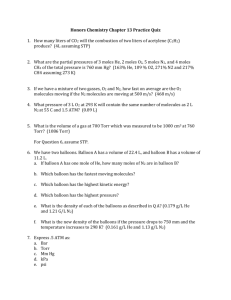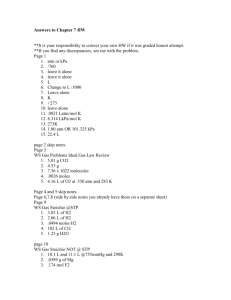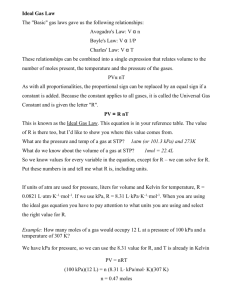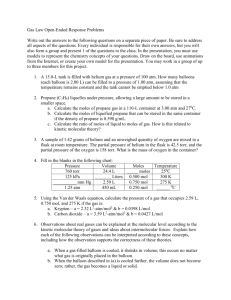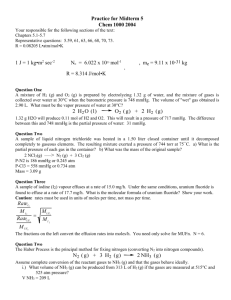Gas Law Notes
advertisement
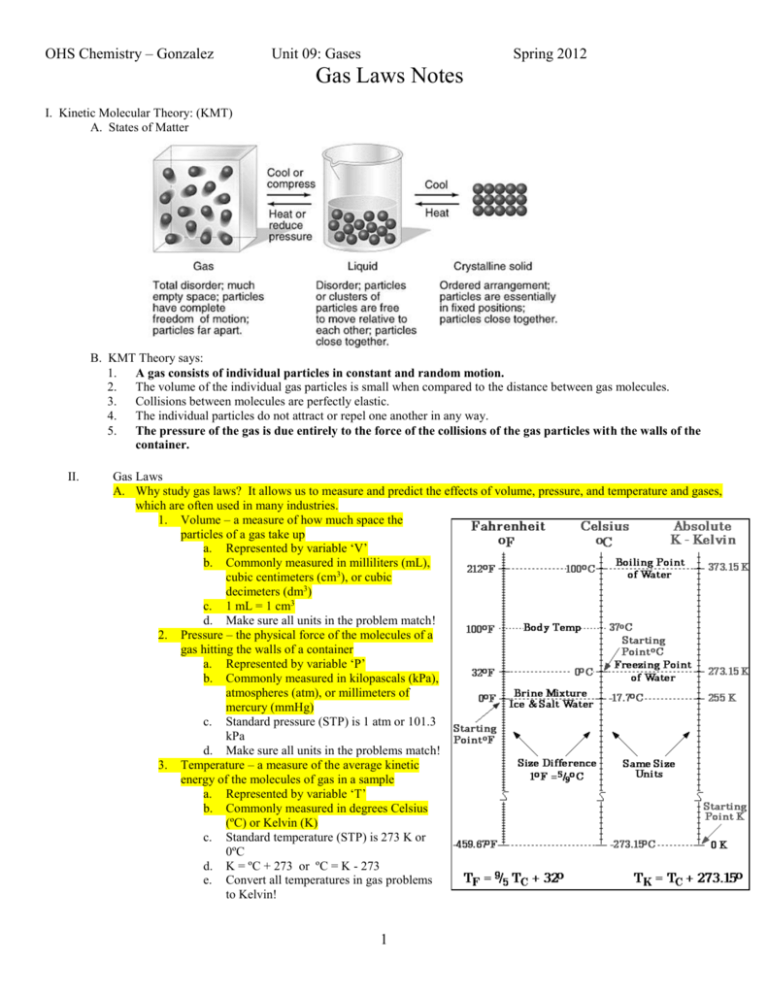
OHS Chemistry – Gonzalez Unit 09: Gases Spring 2012 Gas Laws Notes I. Kinetic Molecular Theory: (KMT) A. States of Matter B. KMT Theory says: 1. A gas consists of individual particles in constant and random motion. 2. The volume of the individual gas particles is small when compared to the distance between gas molecules. 3. Collisions between molecules are perfectly elastic. 4. The individual particles do not attract or repel one another in any way. 5. The pressure of the gas is due entirely to the force of the collisions of the gas particles with the walls of the container. II. Gas Laws A. Why study gas laws? It allows us to measure and predict the effects of volume, pressure, and temperature and gases, which are often used in many industries. 1. Volume – a measure of how much space the particles of a gas take up a. Represented by variable ‘V’ b. Commonly measured in milliliters (mL), cubic centimeters (cm3), or cubic decimeters (dm3) c. 1 mL = 1 cm3 d. Make sure all units in the problem match! 2. Pressure – the physical force of the molecules of a gas hitting the walls of a container a. Represented by variable ‘P’ b. Commonly measured in kilopascals (kPa), atmospheres (atm), or millimeters of mercury (mmHg) c. Standard pressure (STP) is 1 atm or 101.3 kPa d. Make sure all units in the problems match! 3. Temperature – a measure of the average kinetic energy of the molecules of gas in a sample a. Represented by variable ‘T’ b. Commonly measured in degrees Celsius (ºC) or Kelvin (K) c. Standard temperature (STP) is 273 K or 0ºC d. K = ºC + 273 or ºC = K - 273 e. Convert all temperatures in gas problems to Kelvin! 1 OHS Chemistry – Gonzalez 4. 5. Unit 09: Gases Spring 2012 Moles – a measure of how many molecules of a gas are in a given volume a. Represented by variable ‘n’ b. Avogadro’s number: 1 mole = 6.02 x 10 23 molecules Gas Constant – a number used to help with gas problems involving moles a. Represented by variable ‘R’ b. Used in Ideal Gas Law c. Value depends on units used d. Just plug the correct number in after checking the units in the problem B. Boyle’s Law – relates pressure and volume a. When you squeeze a filled balloon (more pressure), the balloon gets smaller (less volume) b. Boyle’s Law states: The volume of a gas varies inversely to the pressure. In other words, volume and pressure react oppositely of one another. c. Equation: P1 x V1 = P2 x V2 , moles and T constant C. Charles’ Law – relates volume to temperature a. When you put a filled balloon in the freezer (less temperature), the balloon gets smaller (less volume) b. Charles’ Law states: The volume of a gas varies directly with the temperature. In other words, volume and temperature react the same as one another. c. Equation: (V1 / T1 ) = ( V2/T2 ) , moles and P constant D. Gay-Lussac’s Law – relates pressure to temperature a. When you squeeze gas in the piston of an engine (more pressure), a small explosion occurs (more temperature) b. Gay-Lussac’s Law states: The volume of a gas varies directly with the pressure. In other words volume and pressure react the same as one another. c. Equation: (P1 / T1 ) = ( P2/T2 ), moles and V constant E. Combined Gas Law - Combines the above three laws a. Just an easy way to remember the three other laws b. Equation: (P1 x V1/ T1 ) = ( P2 x V2/T2 ), moles constant F. Ideal Gas Law – relates measured variables to number of moles a. An ‘Ideal Gas’ always has the same number of moles at the same temperature and pressure, called STP (Standard Temperature and Pressure) (this fact is called Avogadro’s Law) i. Standard Pressure = 1 atm, 760 mmHg, or 101.3 kPa ii. Standard Temperature = 273 K ( K = oC + 273) iii. K = Kelvin temperature always used in gas law problems – must convert! b. Equation: PV = nRT i. n = moles = 22.4L/ mol for any gas at STP = 6.02 x 1023particles/ mol ii. R = universal or “ideal” gas law constant 1. Value depends on the units in the problem a. R = 0.0821 L . atm mol . K b. R = 8.31 L . kPa mol . K c. R = 62.4 L . mmHg mol . K G. Dalton’s Law of Partial Pressures - the pressure of a gas mixture is the sum of the partial pressures of the individual components of the gas mixture. a. Use when a problem gives you multiple pressures of combined gases b. Equation: Ptotal = Pgas 1 + Pgas + Pgas 3 + …….. III. Gas Vocabulary A. Compressibility – ability of gas molecules to be compacted or “squashed” together to make the gas more dense B. Diffusion – movement of molecules of a gas from high concentration to low concentration (spreading out) C. Pressure – force the gas exerts on a given area of the container in which it is contained. D. Atmospheric (barometric) pressure – force exerted on an object by the Earth’s atmosphere. E. Volume – space occupied by a gas F. Fluid – a substance that flows (liquid or gas) 2

